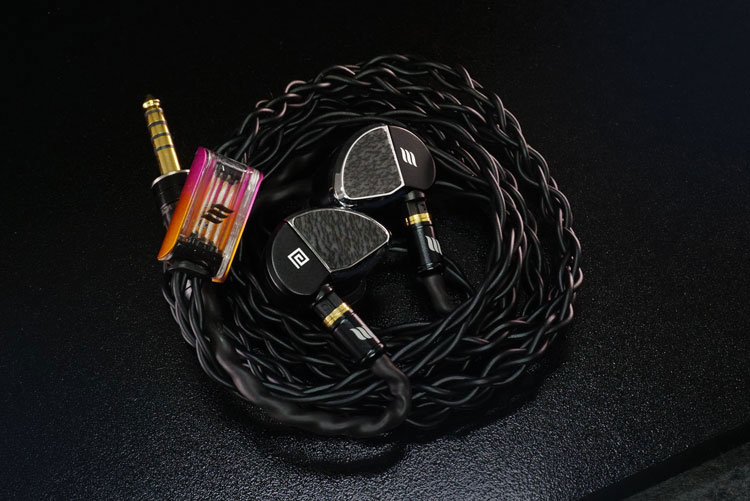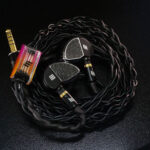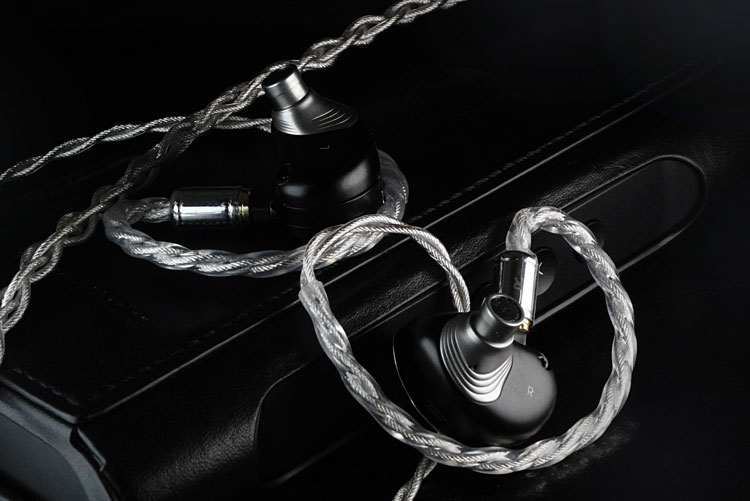The Effect Audio Axiom is a triple driver hybrid IEM with an innovative MU system to vary the tuning and connector options. It is priced at $1499.
Disclaimer: The Effect Audio Axiom was sent to us a sample in exchange for our honest opinion in this review. Many thanks to Effect Audio for giving us this opportunity.
To read more about Effect Audio products reviewed on Headfonics click here.
Note, this 2-page review follows our scoring guidelines for 2021 which you can read up on here.
Axiom: the ancient Greek motif commonly found in Egyptian ruins or Mayan carvings, and a term that can often be interpreted as a premise or a new starting point in modern logic. Either way, it marks the beginning of a new Effect Audio in-house IEM series after an initial foray with King Arthur in 2019.
The boutique cable brand takes an unusual approach, blending together Eastern and Western design elements as well as introducing a practical yet potentially quite innovative modular architecture.
More than this, the new Axiom sees Effect Audio try to strike the right balance between decorative and the theme of “Sustainability”, “Versatility” and “Experience”.
Thus, while the Axiom (non-XP version) is certainly innovative and is also one of the first IEMs to be sold by a cable company that does not come with a cable as standard.
Tech Highlights
For the Axiom, Effect Audio has implemented an innovative inter-switchable ”MU System Module” that will support, according to Effect Audio, a wide variety of sound signatures and cables.
Users will be able to switch between not just MMCX and 2-pin connections, but also different cross-over designs or tuning approaches by purchasing differently tuned and terminated MU modules, (giving more variety for less as part of Effect Audio’s values of sustainability).
In terms of the bread and butter features, the Axiom houses an oversized 12mm magnesium dynamic driver with LCP suspension. The driver not only handles the bass but the midrange frequencies as well. A dual Knowles balanced armature driver handles the highs.
The hybrid, 2-way crossover design employs Effect’s proprietary “RC architecture” with a crossover point at 4,800Hz, maximizing coherence and ensuring smooth articulation in the lower end.
Design
The Axiom design is nothing like other IEMs I have encountered to date. Within the silver trims on the faceplate, the Axiom interlocks an opaque, visually intriguing piece of “He Tian” jade, an amulet synonymous with Chinese royalty.
The finely-cut rare nephrite stone is embedded nearly seamlessly on the metallic faceplate framework making the Axiom one of the most elegant and mesmerizing designs I have reviewed thus far.
I am glad that Effect did not pick old-fashioned green stones which would look very old school. In fact, Effect selected a brown, patterned type of “He Tian” jade which feels artistic in a modern way and very fine to the touch.
The surface of the jade is polished so smooth like how light reflects on water, without any pits, and is very consistent in color. I just hope my pictures do justice to how they look in real life.
MU System Module
Seldom do we see practical and fancy features being put together. On Axiom, Effect Audio introduces their new “MU system Module” which allows users to self-maintain their own choice of sockets and allows different modules to be swapped in a matter of seconds.
The first time I changed the modules it feels a bit too tight so I do recommend getting yourself a flat screwdriver to assist the removal. After which, simply unscrew, snap on the new modules, and put the screw backs, then you are ready to roll.
When you compare the two modules there are some small differences in their size, though it does not affect the fit and you may not be able to notice it. The bright side is that the metallic parts are joined seamlessly and firmly, basically immovable.
The “MU System Module” has stolen my attention for a good while and looking closely at the Axiom there are quite some cool design elements that could be discovered. Elements such as the stepped metallic nozzle parts and that stealthy paint job on the smoothly curved bodywork.
Comfort & Isolation
As a leading cable company Effect Audio has plenty of knowledge on getting users the best fit.
The Axiom’s middle-sized housing with pebble smooth contours sits on the outer ear cozily and without the need to find the best fitting angle. There is no driver flex detected and the shape and size shall fit any ears without issues.
The nozzle doesn’t extend deeply but is long enough to let the flanges hang onto the ear canal well, achieving a satisfactory level of passive noise isolation. After a few hours of listening, it does not cause any pain or stress.
Tips
Uncovering the secret compartment in the packaging you get 3 pairs of ePro ear tips in S/M/L sizes could be found.
The tips supplied are pretty standard with satisfactory quality, comfort, and good sealing power. The Axiom with its shallow fit ensures a big and airy bass as its core signature but it is tip sensitive.
If you have a collection of tips in your arsenal, you should try to roll different options to get the best seal and experience the nuances in the output. I do prefer switching to Spiral Dots or Final E tips for enhanced fit and for pressing down on the lows for in-door listening.
Stock Cable
As a “concept IEM”, the stock cable norms do not apply to the Axiom. The 2 most popular connectors MMCX & 2-pin modules are included for users to pair their own upgrade cables with the Axiom.
There is a bundle discount on Effect Audio’s site for Maestro, EVO 10, and Cleopatra to name but a few options from relatively cheap to high-end. If you want to experience different cables before purchasing, there is a subscription program running on their site for a small fee.
You can also avail of their ConX connector system for a few extra bucks to further enhance the flexibility of your current cable collection.
Packaging & Accessories
The Axiom comes in a small box with a well-thought-out unboxing experience. The colorful gradients on the top hint that the content inside is not short of creativity either.
Unsealing the paper cover, you get a black box with a mystic pattern on top. I am no archeologist so I am not able to decipher the imagery. Effect Audio offered an answer upon inquiring and it is actually Mandarin for the Emperor’s “Xi” which is the royal seal, or a symbol of its royal majesty.
Removing the lid of the box, the earphone units sit right in the middle. You can take off the paper cover around to expose some ear tips, modules exchanging tools as well as the 2-pin module.
Effect Audio intentionally omitted a carrying case, for sustainability’s sake. Clever excuse to not give us their fancy cases, although you may already have a handful of cases at home and personally, I cannot remember when exactly I used a case purely for a cable.
Sound Impressions
It is a very bold-spirited move that negates the existence of “stock tuning” by not including a cable. Therefore, impressions are based on the different cables that you could add on during your Axiom purchase.
That includes the Maestro, EVO 10, and the Cleopatra which were loaned to us, and these cables do not sound close to each other. The Axiom is quite sensitive to source and cable rolling, so you can hear small nuances when switching and comparing, especially in the bass that is most emphasized.
Summary
In general, the Axiom is a paradigm of M-shaped tuning, a joyous tone with good warmth, and a lot of presence for instruments to sound very stereophonic.
The virtuoso is positioned slightly off the head, rendering an expanded soundstage, and is swiftly articulated. The upper end is rounded but not boxy, with some naturalness as a trade-off. The Axiom is also very potent and eloquent in its bass delivery.
Recalling my experience with the Effect Audio King Arthur, which to me, is mediocre in sound, the Axiom feels like a great improvement. It doesn’t fall short of the sonic qualities that are expected for this price point.
To make sure the 12mm dynamic driver gets enough warm-up, I burnt in the Axiom with various tracks and pink noise for 2 weeks, and for me, it sounded more polished and controlled in the vocal line. I find the Cleopatra cable yields the best performance with the Axiom and the below impression is mainly based on this pairing.
Bass
The bass is strikingly powerful, vigorous, and almost overwhelming on the Axiom that challenges your DAP choice in order to tame it down.
It is not the most resolving, fast-impacting bass out there, but it is highly rhythmic and full-sounding when playing techno, piano jazz, and house music. Playing Daft Punk’s Instant Crush, the bass energy down in the 50Hz range is fully captured with string instruments stealing the center stage.
The sustain and harmonics in the air are very nicely captured. Finger plucking or bass string slapping are accurately tracked sounding impressively dense. Microdetail and spatial information and pretty much everything related to the lower bass is magnified and comes alive with the Axiom.
The Axiom’s low-end has plenty of punch, with good unflappability as well as an elaborated decay. It sounds almost over-powered on the phone but when sufficiently powered by DAPs like the Shanling M8 or the M11 Plus LTD, the bass gets under control and sounds more refined.
Cable Tweaks
With the entry-level Maestro cable more sub-bass kicks in and fills the whole headroom with an energetic rumble, but it also pushes back the vocal imaging.
The EVO 10 drags up the density and layering in the bass. It delivers more of a V-shaped curve and pushes more sub-bass out. As such, the guitar and bass get even more presence with quite an audible difference in terms of dynamic range and loudness.
With Cleopatra the bass is slimmer and more balanced, allowing the vocal, chorus, and harmonics to come closer in the picture. The transients in the bass are also the best amongst the three, sounding most natural and effortless.
The timbre and micro-detail on the Cleopatra are most elegant, while the EVO10 strengthens the character of the Axiom. I was not expecting the Axiom to be very sensitive to cable rolling yet every cable roll proved me wrong.
Mids
While the lower frequencies are strongest, the fullness does not bleed into the midrange so vocal lines sound tranquil and smooth. Most energy stays in the mid-lows which gives a stronger presence to the strings. The lower mids to midrange frequencies have a lighter touch, which outlines vocals more swiftly and cleaner without a fat vague image.
With live recordings and small gigs, the Axiom sounds smooth and airy, though it may alter the presentation when it is supposed to sound very intimate. When powered sufficiently, the Axiom sounds very dynamic with EDM/house/club music or any other rhythmic tracks that stresses the mid-bass.
The upper mid-range, around 3-4kHz gets more energized. Higher pitched voices cut through easier and darker voices or instruments. Horns are shyer in presence, somehow less expressive and killing some air, but such reticence reveals more micro details in the lower frequencies.
Cable Tweaks
Switching between the supplied cables, Cleopatra offers the best definition and articulation for strings instruments and synths. You can easily sense the improved level of control with this pairing
The EVO 10 sounds denser in the lower mids and less polished in the upper mids compared to the Cleopatra, leaning more to the bass. Therefore the focus goes more into the instrument fundamentals, making the tuning more V-shaped and breathing more warmth into the lower-end of the mix.
Maestro sounds flatter and warmer, also more neutral in the midrange but not as resolving or as 3- dimensional in imaging as the other 2 cables.
Treble
The treble zone is lifted around 5-7kHz. The overall intensity is not as prominent as the mid-bass range, though still strong enough to bring lighter voices forward cleanly. Beyond the peak after its crossover point, you can hear some sibilance tones subtly presented which gives some good texture to the Axiom harmonics.
The image holds together well when cranking up the volume and actually helps hoarse voices to not sound too altered or rounded. Instruments like flutes are more realistic without some peaks being damped. There is a good use of TWFK here to achieve a proper harmonic balance and openness underpinned by a bass-heavy setting.
Cable Tweaking
Cable rolling has quite a drastic effect on the treble quality. Switching from the more soothing EVO 10 to the Cleopatra you can hear the mids being uncurtained with the dental harshness removed.
The vocal line or upper strings of instruments gets more defined and feel even more polished, whereas the EVO 10 better preserves the dental consonants, sounding rawer but more unaltered.
It is a matter of preference here and listening outdoor to the Maestro and Axiom combo sounds satisfactorily defined and energetic. However, when you switch to the thicker-gauge EVO 10 you will realize there is a lot more potential to be unlocked in the bass.
The silver cable Cleopatra further polishes and brings up more details and separation power, putting more focus on the voices that penetrate through the mix more effortlessly and sounding denser and more coherent.
Staging
As mentioned above, the mids are recessed to a certain extent, carving a spacious stage quality, especially on the x-axis. With an elaborated, airy bass you can hear clearly picking out bass energy dispersing into the rendered headspace.
With good air in the output and the mids being recessive, the staging depth perceived is strong, putting together a bigger picture with less of a focus only on the virtuoso performer.
Out of the three cables I tested the Axiom with, the Cleopatra/Axiom pairing delivered the best vocal power and weight. The overall balance made the stage rendered more realistic.
The EVO 10 sounds smoother, though not as clearly layered, and airy, though its two-pronged V-shape approach stretched the staging wider and deeper.
Click on page 2 below for pairings and select comparisons









